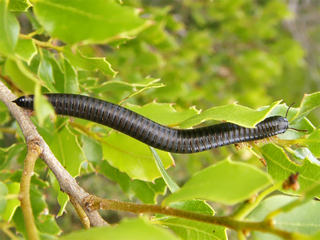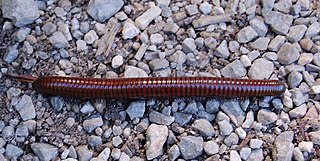
Millipedes are a group of arthropods that are characterised by having two pairs of jointed legs on most body segments; they are known scientifically as the class Diplopoda, the name derived from this feature. Each double-legged segment is a result of two single segments fused together. Most millipedes have very elongated cylindrical or flattened bodies with more than 20 segments, while pill millipedes are shorter and can roll into a tight ball. Although the name "millipede" derives from the Latin for "thousand feet", no species was known to have 1,000 or more until the discovery of Eumillipes persephone, which can have over 1,300 legs. There are approximately 12,000 named species classified into 16 orders and around 140 families, making Diplopoda the largest class of myriapods, an arthropod group which also includes centipedes and other multi-legged creatures.

Mammamia profuga is a species of cave-dwelling millipede in the family Julidae. The only known species of the genus Mammamia, it was described in 2011 from a specimen discovered in a cave in Italy.

Polydesmida is the largest order of millipedes, containing approximately 3,500 species, including all the millipedes reported to produce hydrogen cyanide (HCN).

Ommatoiulus moreleti, commonly known as the Portuguese millipede, is a herbivorous millipede native to the western Iberian Peninsula where it shares its range with other Ommatoiulus species. From here, it has spread by international commerce to a number of new localities. This species was accidentally introduced into Australia without its natural enemies and has since become an invasive pest. A number of methods have been developed to manage this millipede.
Tridontomidae is a small family of millipedes. Its members are endemic to Guatemala. These millipedes range from 22 mm to 28 mm in length. This family includes the remarkable species Aenigmopus alatus, in which adult males feature no gonopods. This millipede is the only species in the infraclass Helminthomorpha without gonopods.

Julidae is a family of millipedes in the order Julida, containing more than 600 species in around 20 genera. Its members are largely confined to the Western Palaearctic, with only a few species extending into the Oriental and Afrotropical realms. They are united by a characteristic form of the mouthparts, and are classified in the superfamily Juloidea of the order Julida, alongside the families Trichoblaniulidae, Rhopaloiulidae and Trichonemasomatidae.

Julida is an order of millipedes. Members are mostly small and cylindrical, typically ranging from 10–120 millimetres (0.39–4.72 in) in length. Eyes may be present or absent, and in mature males of many species, the first pair of legs is modified into hook-like structures. Additionally, both pairs of legs on the 7th body segment of males are modified into gonopods.

Pachyiulus is a genus of julid millipedes containing the following species:

Callipodida is an order of millipedes containing around 130 species, many characterized by crests or ridges.

Ommatoiulus sabulosus, also known as the striped millipede, is a European millipede of the family Julidae. Its common name comes from its two striking bright longitudinal bands on the dorsal surface.

Chordeumatida is a large order of millipedes containing some 1200 species with a nearly worldwide distribution. Also known as "sausage millipedes," they possess around 30 body segments behind the head as adults and reach about 25 mm (0.98 in) in length.

Siphoniulus is a poorly known genus of millipede containing only two living species: S. alba from Indonesia, and S. neotropicus from Mexico and Guatemala. An additional two fossil species are known from Cretaceous amber. Siphoniulus species are the only members of the family Siphoniulidae and order Siphoniulida, making Siphoniulida the smallest millipede order. Few specimens are known, and their classification is contentious, although most recent studies place them as basal members of the Helminthomorpha.

Casimir Albrecht Willem Jeekel (1922–2010) was a Dutch myriapodologist and entomologist known for his major contributions to the taxonomy of millipedes. His 1971 monograph Nomenclator Generum et Familiarum Diplopodorum is credited as launching the "modern era" of millipede taxonomy, and has been considered the "most important single work ever published on the Diplopoda". He served as director of the Zoological Museum Amsterdam, and authored over 150 works on the taxonomy of millipedes and other myriapods.

Titanophyllum spiliarum is a species of cave-dwelling millipede in the family Julidae. The only known species of the genus Titanophyllum, it was described in 2011 from specimens discovered in a cave in Greece. It has several unusual characteristics including eyelessness and a small hook on its hind-most body section that may be involved in keeping the animal ‘locked’ when it coils-up defensively.

Juliformia is a taxonomic superorder of millipedes containing three living orders: Julida, Spirobolida, and Spirostreptida, and the extinct group Xyloiuloidea known only from fossils.

Ommatoiulus avatar is a species of European millipede in the family Julidae. Individuals are known from Andalusia, southern Spain. Individuals are 25 to 38 mm long. Color in alcohol preserved specimens is brownish with yellowish and black marbling on the dorsal surface. O. avatar was described in 2015, with the aid of X-ray microtomography that produced a three-dimensional digital model, becoming the first millipede described from reference to physical type specimens as well as virtual models, known as "cybertypes".

Ommatoiulus sabulosus aimatopodus is a millipede occurring in the South of France; belonging to the same species than Ommatoiulus sabulosus, it differs from the type by the lack of lighter transversal lines on the back when adult. It is believed to be a Mediterranean-climate adapted variant, but whether it is a true subspecies or rather an ecomorph is unclear; first described by Antoine Risso as a distinct species, it is for now considered as a form of Ommatoiulus sabulosus, under the name Ommatoiulus sabulosus f. aimatopodus.

Metopidiotrichidae is a family of millipedes in the order Chordeumatida. These millipedes range from 4 mm to 17 mm in length. Adult millipedes in this family have 32 segments, not the 30 segments usually found in this order. Adult males in this family often feature a reduced or vestigial leg pair 10 as part of the gonopod complex, in addition to the two leg pairs typically modified into gonopods in this order. There are about 9 genera and at least 70 described species in Metopidiotrichidae.
Hoffmaneumatidae is a family of millipedes belonging to the order Chordeumatida. This family includes two genera, one (Hoffmaneuma) found in the Russian Far East and the other (Japanoparvus) found in Japan. Millipedes in this family range from 4 mm to 6 mm in length. Adult millipedes in this family have only 28 segments, not the 30 segments usually found in this order. Adult males in this family feature a reduced leg pair 10 in addition to the two pairs normally modified into gonopods in this order. In the adult male of the species Hoffmaneuma exiguum, for example, the gonopod complex derives from all three leg pairs rather than from just the usual two.

Ommatoiulus lusitanus is a species of milipede endemic to Portugal. It predominantly inhabits grassland but also occurs in Cistus litter.


















